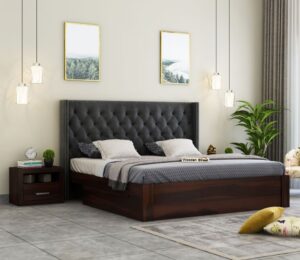
A good night’s sleep is essential for physical and mental well-being, and the bed you choose plays a crucial role in determining the quality of your rest. An uncomfortable or poorly designed bed can lead to back pain, sleep disturbances, and long-term health issues. With so many options available, selecting the right bed can feel overwhelming. However, understanding your needs and preferences will help you make an informed decision that can transform your sleep experience.

1. The Impact of a Good Bed on Sleep Quality
The right bed provides the perfect balance of support and comfort, ensuring uninterrupted sleep. When your body is properly aligned and pressure points are relieved, you can enjoy deeper sleep cycles that contribute to overall health and energy levels. A well-designed bed reduces tossing and turning, allowing you to wake up refreshed and rejuvenated every morning.
2. Choosing the Right Mattress: Key Factors to Consider
Your mattress is the foundation of a good bed. The following factors should be considered when selecting the best mattress for your needs:
- Firmness Level: The firmness of a mattress determines how much support it provides. Side sleepers typically benefit from a softer mattress that cushions the shoulders and hips, while back and stomach sleepers need firmer support to maintain proper spinal alignment.
- Material Type: Mattresses come in various materials, including memory foam, latex, innerspring, and hybrid options. Memory foam conforms to the body, offering pressure relief, while innerspring mattresses provide a traditional, bouncy feel. Hybrid mattresses combine both for optimal support and comfort.
- Temperature Regulation: Some mattresses retain heat, leading to discomfort during sleep. Look for mattresses with cooling technology, such as gel-infused memory foam or breathable latex, to maintain a comfortable temperature throughout the night.
- Motion Isolation: If you share a bed with a partner, motion isolation is essential to prevent disturbances from movement. Memory foam and hybrid mattresses are excellent choices for minimizing motion transfer.
3. Bed Frames and Their Role in Sleep Comfort
A good mattress alone is not enough—a sturdy and well-designed bed frame also contributes to sleep quality. Consider the following bed frame options:
- Platform Beds: These provide excellent support for all mattress types and eliminate the need for a box spring. They offer a sleek, modern look and come in various materials, including wood and metal.
- Adjustable Beds: Perfect for those with medical conditions or specific comfort needs, adjustable beds allow you to raise or lower different sections to achieve the best sleeping position.
- Storage Beds: Ideal for smaller spaces, storage beds come with built-in drawers or hydraulic lift mechanisms to maximize functionality.
- Canopy and Upholstered Beds: If aesthetics matter to you, canopy or upholstered beds add a touch of luxury while providing comfort and support.

4. Importance of Pillow and Bedding Selection
While the bed itself is essential, complementary bedding elements enhance the sleep experience:
- Pillows: Choosing the right pillow based on your sleeping position is crucial. Memory foam, latex, or down pillows offer different levels of support and comfort.
- Bedding Material: Opt for breathable, high-quality fabrics like cotton or bamboo to promote airflow and temperature regulation.
- Mattress Toppers: These add an extra layer of comfort and support, extending the life of your mattress.
5. Customizing Your Sleep Environment
Creating an ideal sleep environment involves more than just selecting the right bed. Consider factors such as:
- Lighting: Dimmable lights or blackout curtains can help regulate sleep cycles.
- Noise Control: White noise machines or soundproofing elements reduce disturbances.
- Room Temperature: Keeping the bedroom at a comfortable temperature promotes restful sleep.
6. Investing in Long-Term Sleep Health
Your bed is an investment in your health. Choosing a high-quality mattress and bed frame may require a larger upfront cost, but it pays off in the long run by preventing sleep-related health issues and ensuring better overall well-being.
Conclusion
Transforming your sleep starts with choosing the right bed. By considering mattress type, bed frame design, supportive bedding, and an optimal sleep environment, you can enjoy restful nights and wake up feeling your best. Prioritize comfort and support, and your sleep quality will improve significantly, leading to a healthier and more productive life.




